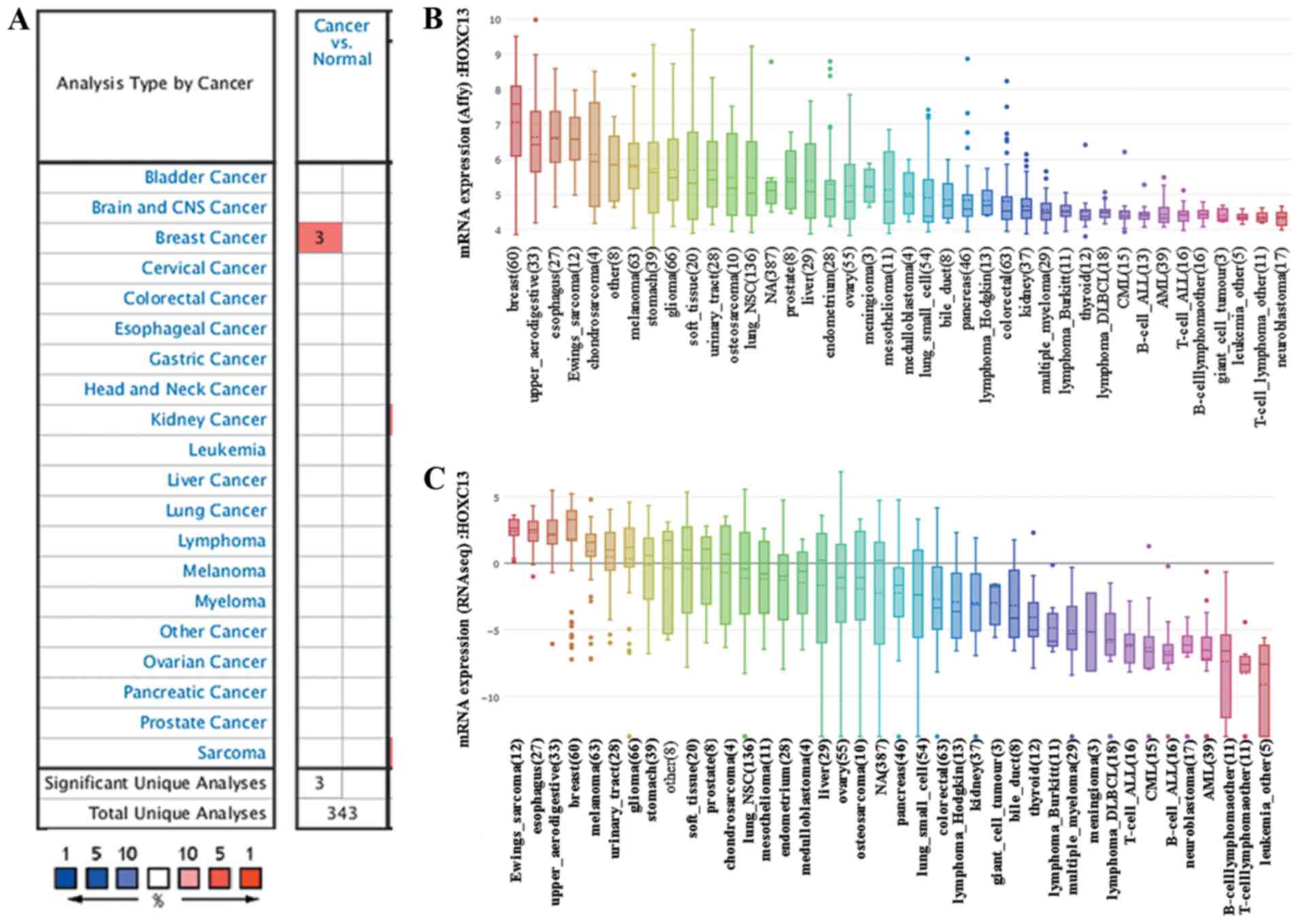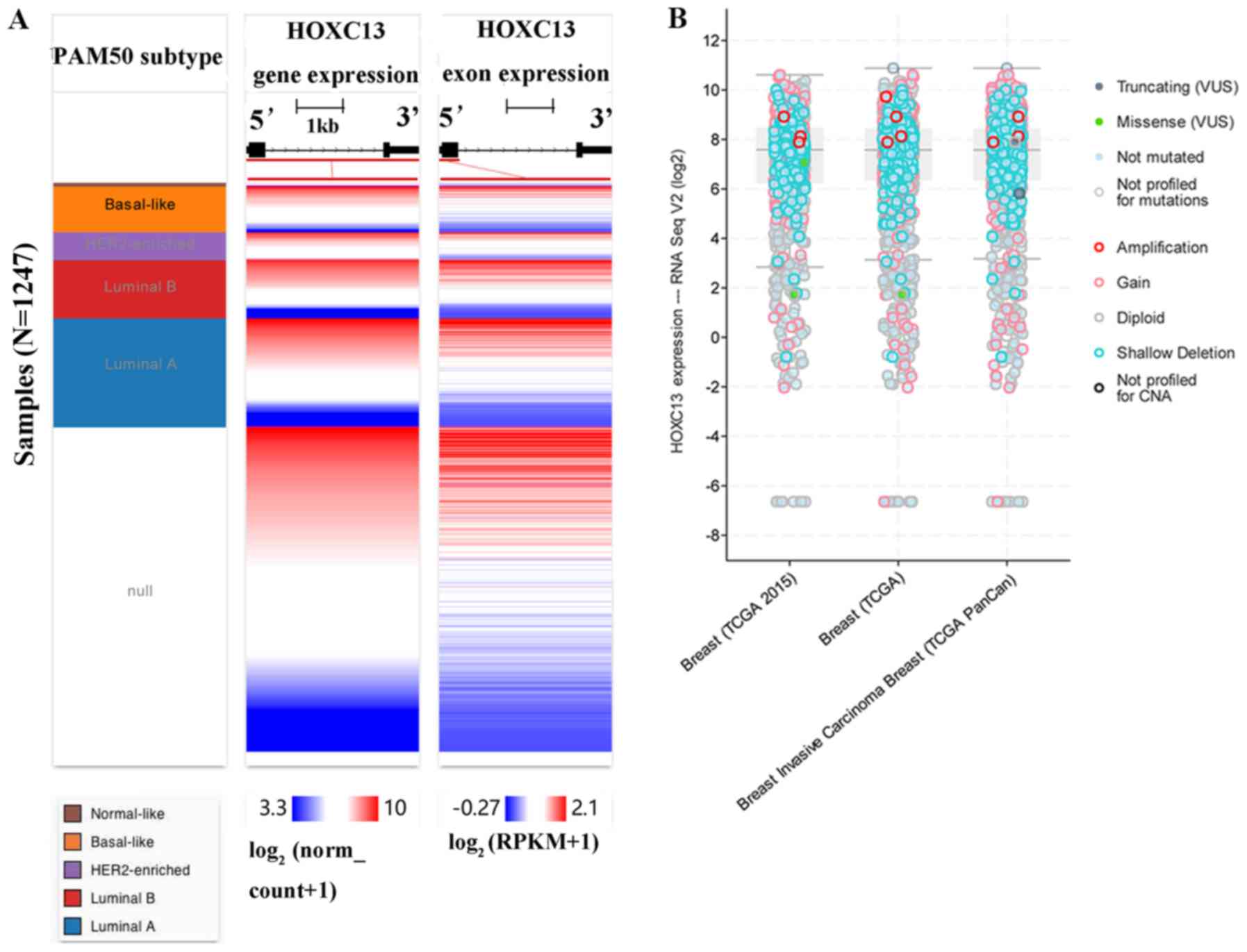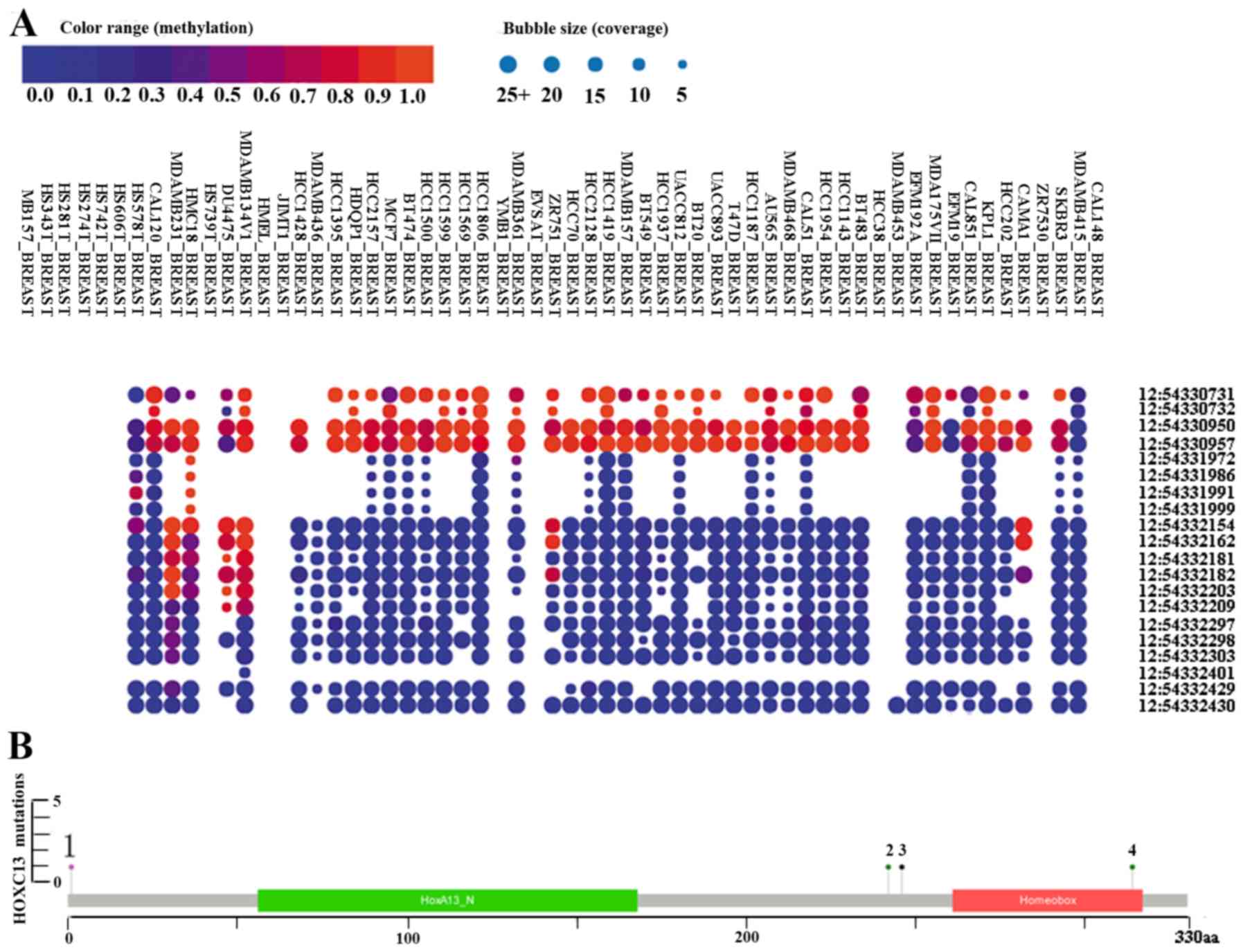|
1
|
Barrios CH, Reinert T and Werutsky G:
Global breast cancer research: Moving forward. Am Soc Clin Oncol
Educ Book. 38:441–450. 2018. View Article : Google Scholar : PubMed/NCBI
|
|
2
|
Harbeck N and Gnant M: Breast cancer.
Lancet. 389:1134–1150. 2017. View Article : Google Scholar : PubMed/NCBI
|
|
3
|
Nathanson KL and Domchek SM: Therapeutic
approaches for women predisposed to breast cancer. Annu Rev Med.
62:295–306. 2011. View Article : Google Scholar : PubMed/NCBI
|
|
4
|
Rousset-Jablonski C and Gompel A:
Screening for familial cancer risk: Focus on breast cancer.
Maturitas. 105:69–77. 2017. View Article : Google Scholar : PubMed/NCBI
|
|
5
|
Luo Z, Rhie SK and Farnham PJ: The
enigmatic HOX genes: Can we crack their code? Cancers (Basel).
11(pii): E3232019. View Article : Google Scholar : PubMed/NCBI
|
|
6
|
Turcotte M, Abadi A, Peralta-Romero J,
Suarez F, Reddon H, Gomez-Zamudio J, Burguete-Garcia AI, Cruz M and
Meyre D: Genetic contribution to waist-to-hip ratio in Mexican
children and adolescents based on 12 loci validated in European
adults. Int J Obes (Lond). 43:13–22. 2019. View Article : Google Scholar : PubMed/NCBI
|
|
7
|
Liu F, Chen Y, Zhu G, Hysi PG, Wu S,
Adhikari K, Breslin K, Pospiech E, Hamer MA, Peng F, et al:
Meta-analysis of genome-wide association studies identifies 8 novel
loci involved in shape variation of human head hair. Hum Mol Genet.
27:559–575. 2018. View Article : Google Scholar : PubMed/NCBI
|
|
8
|
Li L, Wang Y, Song G, Zhang X, Gao S and
Liu H: HOX cluster-embedded antisense long non-coding RNAs in lung
cancer. Cancer Lett. 450:14–21. 2019. View Article : Google Scholar : PubMed/NCBI
|
|
9
|
Bhatlekar S, Fields JZ and Boman BM: Role
of HOX genes in stem cell differentiation and cancer. Stem Cells
Int. 2018:35694932018. View Article : Google Scholar : PubMed/NCBI
|
|
10
|
Vaquerizas JM, Kummerfeld SK, Teichmann SA
and Luscombe NM: A census of human transcription factors: Function,
expression and evolution. Nat Rev Genet. 10:252–263. 2009.
View Article : Google Scholar : PubMed/NCBI
|
|
11
|
Gordon J: Hox genes in the pharyngeal
region: How Hoxa3 controls early embryonic development of the
pharyngeal organs. Int J Dev Biol. 62:775–783. 2018. View Article : Google Scholar : PubMed/NCBI
|
|
12
|
Mallo M: The vertebrate tail: A gene
playground for evolution. Cell Mol Life Sci. Sep 26–2019.(Epub
ahead of print). View Article : Google Scholar : PubMed/NCBI
|
|
13
|
Bhatlekar S, Fields JZ and Boman BM: HOX
genes and their role in the development of human cancers. J Mol Med
(Berl). 92:811–823. 2014. View Article : Google Scholar : PubMed/NCBI
|
|
14
|
Yao Y, Luo J, Sun Q, Xu T, Sun S, Chen M,
Lin X, Qian Q, Zhang Y, Cao L, et al: HOXC13 promotes proliferation
of lung adenocarcinoma via modulation of CCND1 and CCNE1. Am J
Cancer Res. 7:1820–1834. 2017.PubMed/NCBI
|
|
15
|
Svingen T and Tonissen KF: Altered HOX
gene expression in human skin and breast cancer cells. Cancer Biol
Ther. 2:518–523. 2003. View Article : Google Scholar : PubMed/NCBI
|
|
16
|
Shi S and Zhang ZG: Role of Sp1 expression
in gastric cancer: A meta-analysis and bioinformatics analysis.
Oncol Lett. 18:4126–4135. 2019.PubMed/NCBI
|
|
17
|
Cheng L, Shi L and Dai H: Bioinformatics
prognostic biomarkers among Krüppel-like transcription factors
(KLFs) in breast cancer. Cancer Biomark. Oct 12–2019.(Epub ahead of
print). View Article : Google Scholar
|
|
18
|
Yang K, Gao J and Luo M: Identification of
key pathways and hub genes in basal-like breast cancer using
bioinformatics analysis. Onco Targets Ther. 12:1319–1331. 2019.
View Article : Google Scholar : PubMed/NCBI
|
|
19
|
Cheng L, Pandya PH, Liu E, Chandra P, Wang
L, Murray ME, Carter J, Ferguson M, Saadatzadeh MR,
Bijangi-Visheshsaraei K, et al: Integration of genomic copy number
variations and chemotherapy-response biomarkers in pediatric
sarcoma. BMC Med Genomics. 12 (Suppl 1):S232019. View Article : Google Scholar
|
|
20
|
Streit M, Gratzl S, Stitz H, Wernitznig A,
Zichner T and Haslinger C: Ordino: A visual cancer analysis tool
for ranking and exploring genes, cell lines and tissue samples.
Bioinformatics. 35:3140–3142. 2019. View Article : Google Scholar : PubMed/NCBI
|
|
21
|
Fernández-Nogueira P, Bragado P, Almendro
V, Ametller E, Rios J, Choudhury S, Mancino M and Gascón P:
Differential expression of neurogenes among breast cancer subtypes
identifies high risk patients. Oncotarget. 7:5313–5326. 2016.
View Article : Google Scholar : PubMed/NCBI
|
|
22
|
Zen g, Xiao Y, Zhu J, Peng C, Liang W and
Lin H: Knockdown of nucleophosmin 1 suppresses proliferation of
triple-negative breast cancer cells through activating
CDH1/Skp2/p27kip1 pathway. Cancer Manag Res. 11:143–156. 2018.
View Article : Google Scholar : PubMed/NCBI
|
|
23
|
Klonowska K, Czubak K, Wojciechowska M,
Handschuh L, Zmienko A, Figlerowicz M, Dams-Kozlowska H and
Kozlowski P: Oncogenomic portals for the visualization and analysis
of genome-wide cancer data. Oncotarget. 7:176–192. 2016. View Article : Google Scholar : PubMed/NCBI
|
|
24
|
Wen W, Gong J, Wu P, Zhao M, Wang M, Chen
H and Sun J: Mutations in gliclazide-associated genes may predict
poor bladder cancer prognosis. FEBS Open Bio. 9:457–467.
2019.PubMed/NCBI
|
|
25
|
Chen E, Qin X, Peng K, Xu X, Li W, Cheng
X, Tang C, Cui Y, Wang Z and Liu T: Identification of potential
therapeutic targets among CXC chemokines in breast tumor
microenvironment using integrative bioinformatics analysis. Cell
Physiol Biochem. 45:1731–1746. 2018. View Article : Google Scholar : PubMed/NCBI
|
|
26
|
Cerami E, Gao J, Dogrusoz U, Gross BE,
Sumer SO, Aksoy BA, Jacobsen A, Byrne CJ, Heuer ML, Larsson E, et
al: The cBio cancer genomics portal: an open platform for exploring
multidimensional cancer genomics data. Cancer Discov. 2:401–404.
2012. View Article : Google Scholar : PubMed/NCBI
|
|
27
|
Kline CLB, Ralff MD, Lulla AR, Wagner JM,
Abbosh PH, Dicker DT, Allen JE and El-Deiry WS: Role of dopamine
receptors in the anticancer activity of ONC201. Neoplasia.
20:80–91. 2018. View Article : Google Scholar : PubMed/NCBI
|
|
28
|
Gao J, Aksoy BA, Dogrusoz U, Dresdner G,
Gross B, Sumer SO, Sun Y, Jacobsen A, Sinha R, Larsson E, et al:
Integrative analysis of complex cancer genomics and clinical
profiles using the cBioPortal. Sci Signal. 6:pl12013. View Article : Google Scholar : PubMed/NCBI
|
|
29
|
Banerji S, Cibulskis K, Rangel-Escareno C,
Brown KK, Carter SL, Frederick AM, Lawrence MS, Sivachenko AY,
Sougnez C, Zou L, et al: Sequence analysis of mutations and
translocations across breast cancer subtypes. Nature. 486:405–409.
2012. View Article : Google Scholar : PubMed/NCBI
|
|
30
|
Eirew P, Steif A, Khattra J, Ha G, Yap D,
Farahani H, Gelmon K, Chia S, Mar C, Wan A, et al: Dynamics of
genomic clones in breast cancer patient xenografts at single-cell
resolution. Nature. 518:422–426. 2015. View Article : Google Scholar : PubMed/NCBI
|
|
31
|
Martelotto LG, De Filippo MR, Ng CK,
Natrajan R, Fuhrmann L, Cyrta J, Piscuoglio S, Wen HC, Lim RS, Shen
R, et al: Genomic landscape of adenoid cystic carcinoma of the
breast. J Pathol. 237:179–189. 2015. View Article : Google Scholar : PubMed/NCBI
|
|
32
|
Razavi P, Chang MT, Xu G, Bandlamudi C,
Ross DS, Vasan N, Cai Y, Bielski CM, Donoghue MTA, Jonsson P, et
al: The genomic landscape of endocrine-resistant advanced breast
cancers. Cancer Cell. 34:427–438.e6. 2018. View Article : Google Scholar : PubMed/NCBI
|
|
33
|
Shah SP, Roth A, Goya R, Oloumi A, Ha G,
Zhao Y, Turashvili G, Ding J, Tse K, Haffari G, et al: The clonal
and mutational evolution spectrum of primary triple-negative breast
cancers. Nature. 486:395–399. 2012. View Article : Google Scholar : PubMed/NCBI
|
|
34
|
Tan J, Ong CK, Lim WK, Ng CC, Thike AA, Ng
LM, Rajasegaran V, Myint SS, Nagarajan S, Thangaraju S, et al:
Genomic landscapes of breast fibroepithelial tumors. Nat Genet.
47:1341–1345. 2015. View Article : Google Scholar : PubMed/NCBI
|
|
35
|
Jézéquel P, Campone M, Gouraud W,
Guérin-Charbonnel C, Leux C, Ricolleau G and Campion L:
bc-GenExMiner: An easy-to-use online platform for gene prognostic
analyses in breast cancer. Breast Cancer Res Treat. 131:765–775.
2012. View Article : Google Scholar : PubMed/NCBI
|
|
36
|
Jézéquel P, Frénel JS, Campion L,
Guérin-Charbonnel C, Gouraud W, Ricolleau G and Campone M:
bc-GenExMiner 3.0: New mining module computes breast cancer gene
expression correlation analyses. Database (Oxford).
2013:bas0602013. View Article : Google Scholar : PubMed/NCBI
|
|
37
|
Luo J, Wang Z, Huang J, Yao Y, Sun Q, Wang
J, Shen Y, Xu L and Ren B: HOXC13 promotes proliferation of
esophageal squamous cell carcinoma via repressing transcription of
CASP3. Cancer Sci. 109:317–329. 2018. View Article : Google Scholar : PubMed/NCBI
|
|
38
|
Marcinkiewicz KM and Gudas LJ: Altered
histone mark deposition and DNA methylation at homeobox genes in
human oral squamous cell carcinoma. J Cell Physiol. 229:1405–1416.
2014. View Article : Google Scholar : PubMed/NCBI
|
|
39
|
Tatangelo F, Di Mauro A, Scognamiglio G,
Aquino G, Lettiero A, Delrio P, Avallone A, Cantile M and Botti G:
Posterior HOX genes and HOTAIR expression in the proximal and
distal colon cancer pathogenesis. J Transl Med. 16:3502018.
View Article : Google Scholar : PubMed/NCBI
|
|
40
|
Robinson GW: Identification of signaling
pathways in early mammary gland development by mouse genetics.
Breast Cancer Res. 6:105–108. 2004. View
Article : Google Scholar : PubMed/NCBI
|
|
41
|
Tickle C, Crawley A and Goodman M:
Mechanisms of invasiveness of epithelial tumours: Ultrastructure of
the interactions of carcinoma cells with embryonic mesenchyme and
epithelium. J Cell Sci. 33:133–155. 1978.PubMed/NCBI
|
|
42
|
Morgan R and El-Tanani M: HOX genes as
potential markers of circulating tumour cells. Curr Mol Med.
16:322–327. 2016. View Article : Google Scholar : PubMed/NCBI
|
|
43
|
Kamkar F, Xaymardan M and Asli NS:
Hox-mediated spatial and temporal coding of stem cells in
homeostasis and neoplasia. Stem Cells Dev. 25:1282–1289. 2016.
View Article : Google Scholar : PubMed/NCBI
|
|
44
|
Nunes FD, de Almeida FC, Tucci R and de
Sousa SC: Homeobox genes: A molecular link between development and
cancer. Pesqui Odontol Bras. 17:94–98. 2003. View Article : Google Scholar : PubMed/NCBI
|
|
45
|
Godwin AR and Capecchi MR: Hoxc13 mutant
mice lack external hair. Genes Dev. 12:11–20. 1998. View Article : Google Scholar : PubMed/NCBI
|
|
46
|
Comelli L, Marchetti L, Arosio D, Riva S,
Abdurashidova G, Beltram F and Falaschi A: The homeotic protein
HOXC13 is a member of human DNA replication complexes. Cell Cycle.
8:454–459. 2009. View Article : Google Scholar : PubMed/NCBI
|
|
47
|
La Starza R, Trubia M, Crescenzi B,
Matteucci C, Negrini M, Martelli MF, Pelicci PG and Mecucci C:
Human homeobox gene HOXC13 is the partner of NUP98 in adult acute
myeloid leukemia with t(11;12)(p15;q13). Genes Chromosomes Cancer.
36:420–423. 2003. View Article : Google Scholar : PubMed/NCBI
|
|
48
|
Gurevich RM, Aplan PD and Humphries RK:
NUP98-topoisomerase I acute myeloid leukemia-associated fusion gene
has potent leukemogenic activities independent of an engineered
catalytic site mutation. Blood. 104:1127–1136. 2004. View Article : Google Scholar : PubMed/NCBI
|
|
49
|
Cantile M, Scognamiglio G, Anniciello A,
Farina M, Gentilcore G, Santonastaso C, Fulciniti F, Cillo C,
Franco R, Ascierto PA and Botti G: Increased HOX C13 expression in
metastatic melanoma progression. J Transl Med. 10:912012.
View Article : Google Scholar : PubMed/NCBI
|
|
50
|
Woo CJ and Kingston RE: HOTAIR lifts
noncoding RNAs to new levels. Cell. 129:1257–1259. 2007. View Article : Google Scholar : PubMed/NCBI
|
|
51
|
Rinn JL, Kertesz M, Wang JK, Squazzo SL,
Xu X, Brugmann SA, Goodnough LH, Helms JA, Farnham PJ, Segal E and
Chang HY: Functional demarcation of active and silent chromatin
domains in human HOX loci by noncoding RNAs. Cell. 129:1311–1323.
2007. View Article : Google Scholar : PubMed/NCBI
|
|
52
|
Li J, Wang J, Zhong Y, Guo R, Chu D, Qiu H
and Yuan Z: HOTAIR: A key regulator in gynecologic cancers. Cancer
Cell Int. 17:652017. View Article : Google Scholar : PubMed/NCBI
|
|
53
|
Zhang JX, Han L, Bao ZS, Wang YY, Chen LY,
Yan W, Yu SZ, Pu PY, Liu N, You YP, et al: HOTAIR, a cell
cycle-associated long noncoding RNA and a strong predictor of
survival, is preferentially expressed in classical and mesenchymal
glioma. Neuro Oncol. 15:1595–1603. 2013. View Article : Google Scholar : PubMed/NCBI
|
|
54
|
Zhao W, An Y, Liang Y and Xie XW: Role of
HOTAIR long noncoding RNA in metastatic progression of lung cancer.
Eur Rev Med Pharmacol Sci. 18:1930–1936. 2014.PubMed/NCBI
|
|
55
|
Weidle UH, Birzele F, Kollmorgen G and
Ruger R: Long non-coding RNAs and their role in metastasis. Cancer
Genomics Proteomics. 14:143–160. 2017. View Article : Google Scholar : PubMed/NCBI
|
|
56
|
Zhou Y, Zang Y, Yang Y, Xiang J and Chen
Z: Candidate genes involved in metastasis of colon cancer
identified by integrated analysis. Cancer Med. 8:2338–2347. 2019.
View Article : Google Scholar : PubMed/NCBI
|
|
57
|
Pilato B, Pinto R, De Summa S, Lambo R,
Paradiso A and Tommasi S: HOX gene methylation status analysis in
patients with hereditary breast cancer. J Hum Genet. 58:51–53.
2013. View Article : Google Scholar : PubMed/NCBI
|
|
58
|
Zhong Z, Shan M, Wang J, Liu T, Xia B, Niu
M, Ren Y and Pang D: HOXD13 methylation status is a prognostic
indicator in breast cancer. Int J Clin Exp Pathol. 8:10716–10724.
2015.PubMed/NCBI
|
|
59
|
Xia B, Shan M, Wang J, Zhong Z, Geng J, He
X, Vu T, Zhang D and Pang D: Homeobox A11 hypermethylation
indicates unfavorable prognosis in breast cancer. Oncotarget.
8:9794–9805. 2017.PubMed/NCBI
|
|
60
|
Milevskiy MJ, Al-Ejeh F, Saunus JM,
Northwood KS, Bailey PJ, Betts JA, McCart Reed AE, Nephew KP, Stone
A, Gee JM, et al: Long-range regulators of the lncRNA HOTAIR
enhance its prognostic potential in breast cancer. Hum Mol Genet.
25:3269–3283. 2016. View Article : Google Scholar : PubMed/NCBI
|
|
61
|
Botti G, De Chiara A, Di Bonito M, Cerrone
M, Malzone MG, Collina F and Cantile M: Noncoding RNAs within the
HOX gene network in tumor pathogenesis and progression. J Cell
Physiol. 234:395–413. 2018. View Article : Google Scholar : PubMed/NCBI
|
|
62
|
Sun Z, Wu XY and Wu CL: The association
between LncRNA HOTAIR and cancer lymph node metastasis and distant
metastasis: A meta-analysis. Neoplasma. 65:178–184. 2018.
View Article : Google Scholar : PubMed/NCBI
|
















